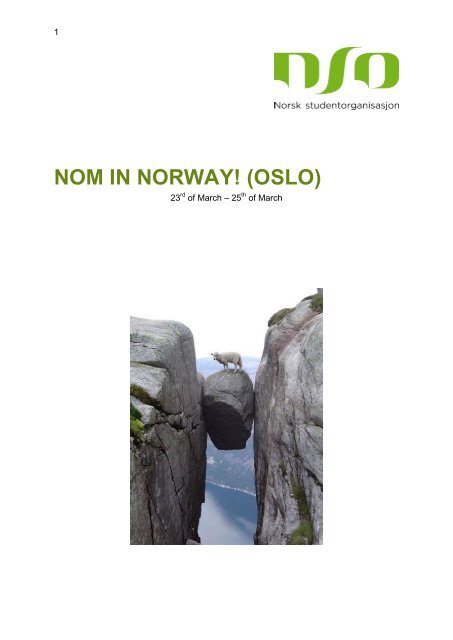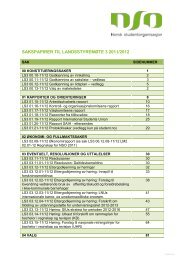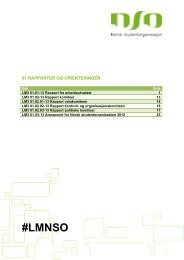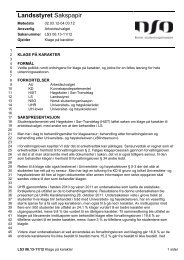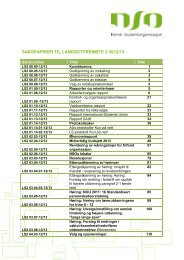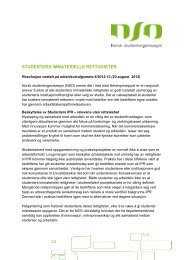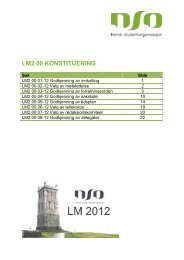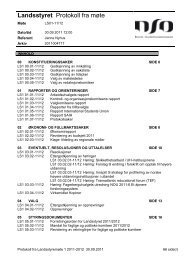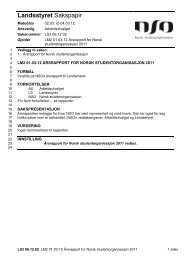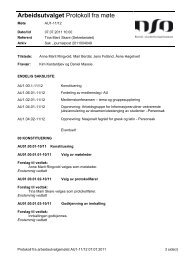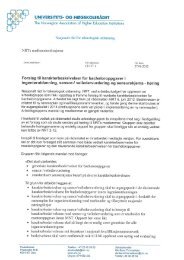NOM IN NORWAY! (OSLO)
NOM IN NORWAY! (OSLO)
NOM IN NORWAY! (OSLO)
You also want an ePaper? Increase the reach of your titles
YUMPU automatically turns print PDFs into web optimized ePapers that Google loves.
1<strong>NOM</strong> <strong>IN</strong> <strong>NORWAY</strong>! (<strong>OSLO</strong>)23 rd of March – 25 th of March
2WELCOME TO <strong>NORWAY</strong>NSO is pleased to welcome you to Norway. We will do our best to make your staycomfortable and enjoyable, and feel free to contact us if you have any concerns aboutyour stay.We hope we have managed to put together an interesting program for you, and we lookforward to cooperating with you all, and to show you some of our Norwegian antics. Wewill take you around to some of the higher education institutions in and around Oslo andyou will meet many of our student representatives.Norway is a beautiful country with all that nature has to offer. We can’t promise to showyou northern lights or exotic arctic animals, but we promise you a nice time in ourbeautiful capital Oslo.March is generally quite chilly, so remember to bring warm clothes. Average temperaturein March is minus just below zero degrees, so bring your warmest clothes!We look forward to seeing you all in Oslo!On behalf of the EC of NUS NorwayKim KantardjievPresidentNUS Norway
3CONTENT<strong>NOM</strong> <strong>IN</strong> <strong>NORWAY</strong>! (<strong>OSLO</strong>)............................................................................................. 1Welcome to Norway ......................................................................................................... 2Content ............................................................................................................................ 3Practicalities ..................................................................................................................... 4Contact details .............................................................................................................. 4Finances ....................................................................................................................... 4Housing ........................................................................................................................ 4How to get there? ......................................................................................................... 4Weather ........................................................................................................................ 4Good to know ............................................................................................................... 4Norway ............................................................................................................................. 6the history of higher education in norway ......................................................................... 7Oslo ................................................................................................................................. 8University of Oslo ......................................................................................................... 9NSU + StL = NSo ........................................................................................................... 10NSU ............................................................................................................................ 10StL .............................................................................................................................. 10Merger ........................................................................................................................ 10NUS Norway - NSO .................................................................................................... 10
4PRACTICALITIESHere overview of practical information that is needed for your stay in Norway.Contact detailsYour main contact persons will be: Daniel Massie (+47 982 25 995) (main contact for the stay.) Jens Folland (+47 982 25 994)FinancesThe standard <strong>NOM</strong>-rules apply. NSO will cover the hotel and food costs, which is greatfor you guys, since food is generally expensive in NorwayHousingYou will live in Thon Hotel Spectrum, which is very close to all public transportation, citycentre as well as the office. Below is a map that outlines the city centre, where you canfind NSO office (1), hotel (2), subway stations (3 &4), and railway station (5).How to get there?When you get to the airport (Oslo Airport Gardermoen [OSL]) take the “Oslo AirportExpress” train to the Oslo Central Station (Oslo S). The train uses approximately 20minutes to the central station. If you text either Daniel or Jens when you get on theAirport Express train, there will be someone to meet you at/by the platform when youarrive at Oslo Central Station.WeatherThe weather in March will be what we in Norway call ‘bælkaldt’, which is colder thatfreezing. Regular temperatures in the Oslo area is somewhere between -5 to -15degrees, although it’s usually very beautiful as there isn’t that much wind and mostlyclear weather. Bring warm clothing, mittens, cap and whatever you can fit in yourluggage of warm clothing as you are going to need it. It is regular in Norway to have atleast two layers of clothing if not more (this is not including the outer layer), during winter.Fortunately the sun rises at 6 am, and sets at 7 PM, so it’s not as dark as it is during themiddle of the winter. That’s good to know for all of you early birds out there.Good to knowWe use the European standard plug (that practically every country in Europe usesexcept the Swiss) so you won’t need an adapter.
5We use the Norwegian Krone (NOK), which is different from the Swedish andDanish Krone. One Euro is approximately 8 NOK.It’s quite expensive in Norway (that you already know)Cheapest alcohol is at airport tax free store.We don’t have any trolls in Norway, even though the tourist stores want allforeigners to believe so.
6<strong>NORWAY</strong>Norway is a country at the top of Europe. Many people know Norway through the mythsof the Vikings who sailed down Europe to rob poor Europeans. Not many people thoughtback then that there was any hope for academics to survive in this rough country whereboth the people and the nature where wild.Many things have happened since the Vikings ruled. Norwegians got higher education,started to drink café latte and are in general more civilized than before. Although,Norwegian still like to be a bit different. For example is Norway not a part of theEuropean Union, and the movement against Norwegian membership are stronger thanever before.Norway has a constitutional monarchy where the king is the head of the state. It must besaid that the king’s political role are almost non-existing, while his role is mostly as anambassador. So the prime minister is the political leader of the nation, and the king’swork mostly consist of smiling, nodding and waving to the people. At this point Norwayhave a government coalition from the left wing including three parties; The Centre Party,The Labour Party and the Socialist Left Party.Among the political and academic things Norway is famous for is the Nobel Peace Prizewhich has its administration and the Nobel Peace Prize Galla (where the winner gets theprize) located in Oslo. Another thing Norway is famous for is that we always get 0 pointsin the Eurovision Song Contest.Norway is divided into 19 fylkeskommuner, which are the first level administrativecounties, and then Norway have 430 second-level administrative municipalities. Thesmallest municipalities have some 100 people, while the biggest is Oslo with 600.000citizens. The counties and municipalities have elections every fourth years, and the localgovernments are chosen.As you might know Norway has rich nature resources. Some of the most importantindustries in Norway are fisheries and farming, but also energy through water is animportant industry. It can even happen on rainy days that Norwegians think there are alittle bit too much water in Norway. One of the other significant industries are the oil andgas industry where Norway is world leading in gaining oil and gas from platforms in thesea.The tourist industry are not as big industries as the already mentioned ones, but stillmaybe more famous. Who does not connect Norway with mountains, midnight sun,aurora borealis and fjords? If you’ve read Douglas Adams’ Hitchaikers Guide to Galaxyyou’ve already noticed that the Norwegian fjords are used in the literature. Adamsdescribes a character called “Slartibartfast” who’ve one single interest in life; to makeNorwegian fjords. He says this is important for him because it gives him the uniquebaroque feeling.So we also hope that the study visit team will go home with an unique and baroquefeeling after the stay.
7THE HISTORY OF HIGHER EDUCATION <strong>IN</strong> <strong>NORWAY</strong>The higher education in Norway is based upon a humboldtian idea of higher educationwith high autonomy to the institutions and high academic freedom to the students andresearchers. Although the Norwegian system is based on Humboldts thoughts therehave been certain values and national adaptions. Education is important in the so-calledScandinavian social model. The results of this are that equality and access have beenemphasized, and this have led till the system with campuses all over Norway. Forexample can you find higher education institutions at places with only a few 1000citizens.But let us go back to the first higher education institution in Norway. University in Oslo isthe oldest institution in Norway and during 2011 University of Oslo will celebrate 200 yearas a university. Back then it was radical to start a university in Oslo. This is because ofthe union with Denmark, and it was radical to start a university in the “remote” city ofOslo. But the university was founded and was a significant factor in the academicNorway. One of the major subjects for students and academics during the early yearswere to manage to get buildings for the university, and another big topic which interestedthe university was the Norwegian independence.It was a long time before new universities was established in Norway. Not until after theSecond World War the next university, University of Bergen, was founded by law. Andthe next university which was founded was University of Tromsø in the 60s.Although Norway in the start had very few universities there were several importantprofessional institutions and educational institutions in Norway. One of the mostimportant ones was the teacher, technical and nursery schools who were all over thecountry. Many of these rised in the biginning of the last century. Other importantacademic institutions were the museums which got closely connected to the newuniversities.One of the more important decisions in the higher education in Norway was to startacademic institutions in the districts (region schools.) Several institutions were started allaround Norway and had various educations as history, sociology, journalism, social workand other academic fields that were important for the local communities near the“regional schools.” The whole ideas behind these schools were to provide competence tothe communities around Norway.Two interesting things happened with these schools. One of the most important thingsthat happened was that they become closely connected to already existing institutions. Italready was a structure with professional studies all over Norway. As an example itbecame usual for the history studies to cooperate closely with the teacher schools. Aftera reform of the higher education sector in 1994 several of these professional schools andthe regional schools got merged into what we today call university colleges.Another important development with the regional schools were that they becomeresearch based. The regional schools recruited their teachers from the universities, andthese academics had ambitions on continuing doing research. Another possible
8explanation is that counties and the regions themselves got high ambitions for their ownregional schools. Suddenly the regional schools had become mini-universities with botheducation and research. The first professor on these regional schools were hired atNordland Regional School in the late 80s, and today we’ve seen some of the regionalschools have gained university status, while other have ambitions of more research andeven to be full scaled universities.There is also worth to mention that the increase of students at the regional schools washigh and the capacity were increased tremendously during the 70s, 80s and 90s.As mentioned there was a reform for higher education in 1994. The goals for this reformwere to increase the quality of higher education, and especially the quality of theresearch done in the sector. This led to several mergers of institutions in highereducation. Mainly these were merging by the professional schools and the regionalschools. The institutions got bigger and some institution even got responsible for wholecounties.This willingness to merge is still seen today. After a reform in 2003 the law for highereducation was changed. One of the more significant changes was that the institutions gothigher autonomy, and also that there was possibilities to change status within theinstitutional categories we have in Norway. After the law we’ve seen four newuniversities, one new specialized university institution and several new universitycolleges. There have also been a drift towards merging of higher institution. The questionabout structures in higher education have become one of the most difficult and importantdebates in the higher education sector in Norway today.<strong>OSLO</strong>Oslo is the capital of Oslo, and the Oslo region holds approximately ¼ th of theNorwegian population (1.4 million people). Oslo is a multicultural city, the seat ofParliament, Government and most state functions. Oslo is furthermore a city of highereducation and research. Oslo is the seat of the oldest and biggest University in Norway(University of Oslo), the University College of Oslo and Akershus, a number ofspecialized university institutions (most of national character) as well as a handful ofprivate institutions. In total, there is approximately 70 000 students in Oslo, as well as anumber of research institutes.However, Oslo is considered a small city, as it will take you less than 30 minutes to walkfrom one side of the city centre to the other. And in reference to the size of the city it isworth noting that Oslo is the only capital in the world where you can take the subwaydirectly into ‘the wild’. 30 minutes with subway from the city centre is the woods, whereyou can go cross country skiing for miles and miles at a time.Oslo is an urban city, so you will find everything you need from bookshops to musicstores, to cafés and restaurants less than a 5 minute walk from your hotel.
9University of OsloThe Royal Frederick University was established in 1811 (celebrating its 200 th anniversaryin 2011), and was the first higher education institution in Norway. It was established at atime when Norway still was a part of Denmark (Norway was given to Sweden in 1814 inwar-damages from the Napolean war). Up to the establishment of the University of Osloin 1811, all Norwegians longing for knowledge had attended University in Copenhagen.In 1939 the name changed to University of Oslo, and up until 1946 University of Oslowas the only University in Norway.The University has 8 faculties and two main campuses, the campus in the city centrewhere the faculty of law is situated, and Campus Blindern. Campus Blindern is the maincampus, and is closely connected to the rest of the faculties. With almost 30 000registered students, the University of Oslo is the biggest higher education institution.Compiled with academic and administrative staff it has the same size as an averageNorwegian municipality.
10NSU + STL = NSONSUNorsk Studentunion (NSU) was established in 1936 and was a special interest partypoliticalindependent organization for close to 93 000 students at universities, as well ascolleges for the fields of art and science. NSU worked at improving the students’academic, social and financial rights. NSUs highest body was the national assembly.StLStudentenes Landsfobund (StL) was established in 1996 and was Norway`s largeststudent organization representing 100 000 students at 29 institutions of higher education.StL was party-political independent and worked at promoting the students` financial,cultural, social and democratic interests.MergerA merger between NSU and StL was up for discussion for a long time and wasattempted twice. Each organization said no at their national assemblies respectively. In2008 a negotiation group was appointed and its goal was to make a merger documentwhich was going to lay the groundwork for a new national student organization, based ona merger between NSU and StL. In 2009 StL and NSU held their national assemblies,and in both organizations the merger document and a decision to merge was passed.The merger document was used as a starting point for the work laid down in bothorganizations towards the meeting of establishment held in April 2010.NUS Norway - NSOWas officially established on the 1st of July 2010, and is an umbrella organization forstudent democracies at the institutions of higher education in Norway. NSO representsabout 200 000 students and holds an important voice for the students of Norway. NSOworks actively towards politicians, the bureaucracy, media, the Norwegian StateEducational Loan Fund and the managements at the institutions of higher education toimprove the students’ academic, social and financial conditions.


